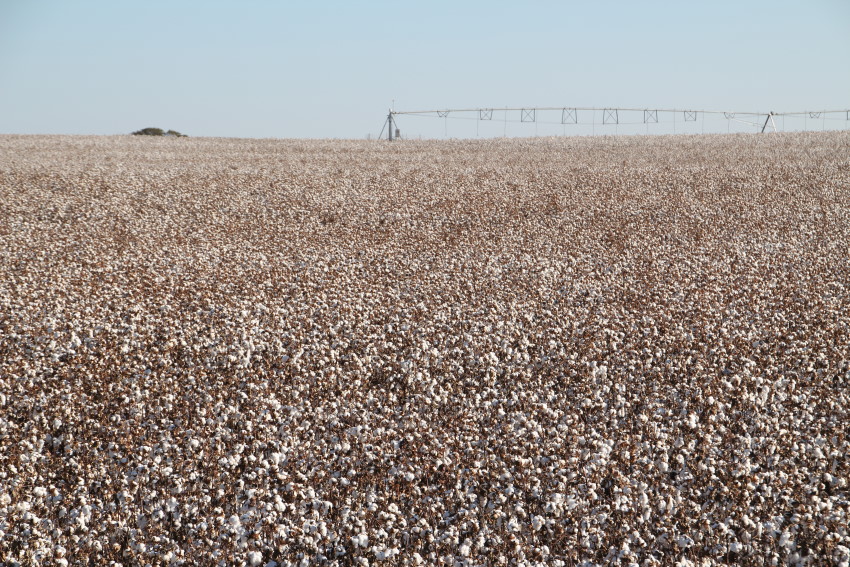
Agricultural News
National Cotton Council Sees Almost Fifteen Percent Fewer Acres Planted to Cotton This Spring
Sun, 08 Feb 2015 14:22:13 CST
 U.S. cotton producers intend to plant 9.4 million acres of cotton this spring, down 14.6 percent from 2014, according to the National Cotton Council's 32nd Annual Early Season Planting Intentions Survey.
U.S. cotton producers intend to plant 9.4 million acres of cotton this spring, down 14.6 percent from 2014, according to the National Cotton Council's 32nd Annual Early Season Planting Intentions Survey.
Upland cotton intentions are 9.2 million acres, down 15.2 percent from 2014, while extra-long staple (ELS) intentions of 236,000 acres represent a 22.8 percent increase. The survey results were announced today at the NCC's 2015 Annual Meeting in Memphis. Click on the PDF link at the bottom of this story to see the state by state listing of 2015 estimates versus 2014 actual plantings.
The planted acres in Oklahoma are predicted to be down 15,000 acres from last year's actual planted number of 240,000 acres, which is off 6.2%. Texas plantings are expected to drop 13.8%- estimated for 2015 at 5.343 million acres. Wheat is the expected beneficiary based on the Oklahoma survey results. In south Texas, respondents indicate a shift out of cotton and into grain sorghum. Respondents from Texas' Blacklands region are moving predominantly to wheat, with a smaller shift to corn. In West Texas, the acres shifting away from cotton are split between wheat, corn and grain sorghum.
Dr. Gary Adams, the NCC's vice president Economics & Policy Analysis, said, "Planted acreage is just one of the factors that will determine supplies of cotton and cottonseed. Ultimately, weather, insect pressures and agronomic conditions play a significant role in determining crop size."
He said that with average abandonment for the United States at 12.8 percent, Cotton Belt harvested area totals 8.2 million acres. Weighting individual state yields by 2015 area generates a U.S. average yield per harvested acre of 817 pounds. Applying each state's yield to its 2015 projected harvested acres generates a cotton crop of 14.0 million bales, with 13.3 million bales of upland and 694,000 bales of ELS.
The NCC questionnaire, mailed in mid-December 2014 to producers across the 17-state Cotton Belt, asked producers for the number of acres devoted to cotton and other crops in 2014 and the acres planned for the coming season. Survey responses were collected through mid-January.
Adams noted, "History has shown that U.S. farmers respond to relative prices when making planting decisions. Cotton growers are approaching the 2015 planting season with harvest-time futures contracts at the lowest level since planting of the 2009 crop. After more than five years of stronger markets, cotton prices fell sharply during the second half of 2014."
Survey respondents throughout the Southeast indicated a 10.6 percent decline, lowering the regional total to 2.39 million acres. Declines are expected in each of the region's six states as cotton acres move into competing crops. Even with the expected reduction, the region's cotton acreage remains well above the recent low of 1.89 million acres in 2009. In Alabama, the survey responses indicate a shift to peanuts and soybeans, while Florida's acreage is almost exclusively moving to peanuts. In Georgia, the acreage shifts are more varied with peanuts, corn and soybeans all expected to pull acres from cotton with South Carolina looking at a similar scenario. In North Carolina, the shift is to soybeans, while corn benefits from the modest decline in Virginia.
In the Mid-South, survey results show that growers intend to plant 1.08 million acres, a decrease of 25.9 percent. As was the case in the Southeast, all Mid-South states responded with intentions to plant less cotton in 2015. Without exception across the five states, the respondents indicate that cotton acres will move into soybeans for 2015.
The West accounts for the largest percentage reduction across the four production regions. With upland intentions of 134,000 acres, those producers are expecting to plant 46.6 percent fewer acres of upland cotton. The 2015 acreage represents a new low for recent history.The survey results for Arizona suggest a shift from cotton to wheat, as well as the 'other crops' category. Upland growers also indicate a shift to ELS cotton. In New Mexico, the cotton reduction coincides with responses indicating more acres of grain crops.
Survey results indicate U.S. cotton growers intend to increase ELS plantings 22.8 percent to 236,000 acres in 2015. If realized, that total would exceed the five-year average by 18,000 acres. ELS results reflect both the fact that ELS prices remain more attractive relative to upland cotton and likely capture expectations during the survey period of improved 2015 water availability in California. Final acreage will be affected by actual water allocations, which remain uncertain. NCC delegates were reminded that these expectations are a snapshot of intentions based on market conditions at survey time. Actual plantings will be influenced by changing market conditions and weather.
NationalCottonCouncilPlantings2015.pdf
WebReadyTM Powered by WireReady® NSI
Top Agricultural News
More Headlines...



















